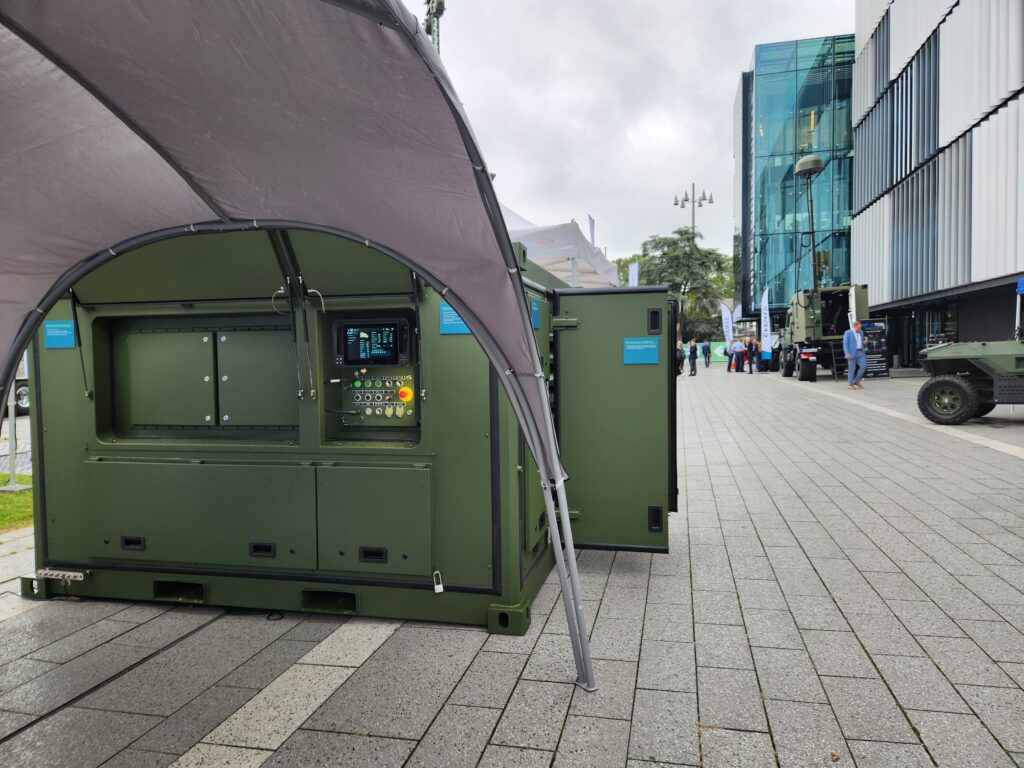VINCORION’s engineering skills are evident in this prototype: the 50-kilowatt version of the PGM low emissions power generator was unveiled in Koblenz on Wednesday, September 4, 2024.
The pre-series model of the new genset for the German Armed Forces was demonstrated for the first time at the “RÜ.NET” trade fair in Koblenz. RÜ.NET is a major event at which the German Armed Forces and industry exchange information on various topics in the sector. It takes place in Koblenz.
With the new power generator, the engineers at VINCORION have created a genset that meets the high requirements of the armed forces in mobile operations and at the same time has a number of unique selling points: These include tactical advantages through greater energy efficiency and lower fuel consumption, as well as reducing the burden on personnel through simple operation. This technology can meet the growing energy requirements of modern armed forces.
Tactical advantages through low consumption
The 50-kilowatt prototype was presented to the public by Daniel Zeitler, Head of Strategy and Product Management, together with Martin Eisenschmid, Director Business Development and Sales. “The highlights of this genset for the Bundeswehr are that it enables interconnected operation as a so-called modular grid, but also the exhaust gas aftertreatment for low-emission operation and the innovative control system including new energy management,” said Daniel Zeitler.
“Our team has carried out intensive development work to ensure that the SEA prototype meets the high requirements of the German Armed Forces,” explained Martin Eisenschmid. He demonstrated on site how the device, with its user-friendly technology, shows the operating status at all times, for example via a display.
The aim is clear: to relieve users as much as possible of the burden of operating the power supply, freeing up personnel for other tasks. Training and maintenance costs are also reduced and the devices can be put into operation more quickly. “Although we are introducing a completely new technology with the battery storage systems, operation requires less training and expertise than before thanks to a highly automated and standardized control system,” says Zeitler. Such technology is not readily available on the market, he emphasizes, and is specially tailored to the requirements of the armed forces in action. This includes, for example, reduced noise emissions – which lead to tactical advantages. But it also improves occupational safety and environmental protection.
Breakthrough: The Emission-Downgrade-Technology
The generators can run in combination, regardless of whether devices with 50 or 200 kilowatts of power are used – and with modern battery storage systems. Coupling to renewable energy systems such as photovoltaic modules is also possible. Finally, the genset can be connected to the power grid – in this case, no fuel would be consumed at all.
“The emission downgrade technology was a decisive breakthrough,” Zeitler noted. In regular operation, the diesel engine is used with the Stage V class. There is also the “emission downgrade” mode, with which all NATO fuels can be used, including those that are contaminated. This would make it possible, for example, to operate abroad in the case of an alliance. If the gensets are coupled with the battery storage system, energy efficiency can be greatly increased. “This saves fuel, which in turn is a major tactical advantage,” explained Zeitler. Last but not least: the gensets offer a high degree of mobility, as there are standardized transport interfaces with ISO mounts. In the case of the 50-kilowatt genset, this is a 10-foot container.
Backbone of the modern mobile power supply
A key advantage of the SEA prototype is therefore its environmental friendliness. The generator emits up to 30 percent less CO₂ thanks to its lower consumption and coupling with storage systems. This supports the Bundeswehr on its path to climate neutrality and shows that efficient energy supply and environmental protection can go hand in hand.
Whether deployed in Europe or abroad, the Bundeswehr requires a secure energy supply. Obsolescence management, i.e. the timely replacement of parts over many years of operation, was an important criterion in the decision in favor of VINCORION, alongside environmental protection. The technology company relies on a high level of vertical integration and also guarantees the integration of future interfaces. For example, the same VINCORION software with its own controllers is used in the PGM and ESM – which can be a major advantage in the event of bottlenecks in the supply chain.

Tactical advantages meet resource friendliness with the new PGM low-emission genset (50 kW).
